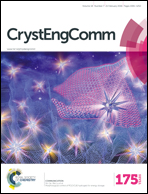Photoluminescence enhancement induced by a halide anion encapsulation in a series of novel lanthanide(iii) coordination polymers†
Abstract
Nine new isostructural 2D lanthanide(III) coordination polymers (Ln-CPs) with a general formula of {[Ln(Bcpi)2(H2O)]BrxCl1−x·(H2O)}n {Ln = Eu (1–3), Tb (4–6) and Gd (7–9); x = 0, 0.5, 1; Bcpi = 1,3-bis(4-carboxyphenyl)imidazolium} were synthesized by hydrothermal reactions and fully characterized. Single-crystal X-ray structural analysis revealed that this series of Ln-CPs displays 1D channel motifs with encapsulated halide anions, whereas their overall 2D metal–organic networks can be topologically classified as kgd underlying nets. Compounds 1–3 show five characteristic emission lines with maxima at 579, 591, 617, 652 and 701 nm due to the 5D0 → 7FJ (J = 0–4) transitions, respectively. Besides, compounds 4–6 exhibit four sharp peaks at 487, 544, 582 and 619 nm resulting from the 5D4 → 7FJ (J = 6–3) transitions. The emission spectra indicate that the halide anions captured in the porous structure could induce the enhancement of photoluminescence. Furthermore, the emission strength and quantum yield increase when the encapsulated choride anions are replaced by bromide anions. In addition, by using the in situ doping method, a series of heterometallic Tb/Eu coordination polymers {[Tb1−xEux(Bcpi)2(H2O)]Cl·(H2O)}n (10) with different contents of metals {x = 0.001, 0.002, 0.005, 0.01, 0.02, 0.03, 0.04, 0.05, 0.1 and 0.2} were generated, which are tunable yellow light luminescent materials and simultaneously display two major emission bands at 612 and 545 nm due to Eu(III) and Tb(III) emission, respectively.


 Please wait while we load your content...
Please wait while we load your content...